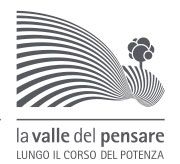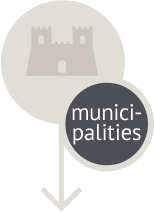THE ARCHAEOLOGICAL MUSEUM
The archaeological museum is situated in the convent of Saint Francesco. It contains some fragments of sculpture, several inscriptions and some important Egyptian finds which testify to the link between the classical Trea and some oriental civilizations, in particular the Egyptian culture.
The ancient Trea was situated in the area where the sanctuary of SS. Crocifisso stands today, 1.5 Km from the modern town; this is an important area for research because of the abundance of finds.
Here, archaeologists discovered the remains of a temple of the mid II century A.D, dedicated to Isis and Serapis, two Egyptian deities.
At the beginning of XX century, in this territory, important discoveries were made: in 1902, the ancient church of SS. Crocifisso was seriously damaged by fire, following which it was demolished and rebuilt. The demolition led to the finding of two Egyptian statuettes which were bricked in the façade of the bell tower of the sanctuary where they remained till 1996, when they were removed, restored, and then placed in the museum.
THE TERRITORY OF TREIA FROM PREHISTORY TO THE ROMAN AGE
The activity of reconnaissance, carried out by a group of archaeologists from the Belgian University of Gelt, has underlined that, in the territory of Trea the settlements, during the prehistoric age, were widespread.
A series of finds testify to the fact that this area was quite densely populated during the Bronze Age because of its proximity to the Bronze Age site of Monte Francolo, near Pollenza and because many important routes converged there.
This road network, which runs along the valley of the river Potenza was the main channel of communication between the Adriatic Sea and the Appennine passes. So vital was it that it influenced the history of settlements in this territory.
In the period known as the Picenis civilization, the settlements were more crowded in the valley and followed the route which was later, during the Roman Age, to become the link road with the Via Flaminia. (In ancient times this link road represented the quickest route between Rome and the Adriatic Sea. It turned off from Via Flaminia in Nuceria Camellaria, the modern Nocera Umbra, passed through the Termine pass and went on towards "Dubiae", "Prolaqueum"- Pioraco- Trea, "Auximum"- Osimo- as far as Ancona.)
The important IV century B.C. remains found in S.Maria in Selva which show that Celtic- Etruscan- Picenis cultural aspect, common to the North of the river Esino, confirm the importance of this link road which was preferred to the more practicable route, often controlled by the Celts.
THE SITE OF S. MARIA IN SELVA
The site of S. Maria in Selva is on the top of a hill, on the left of the river Potenza.
It was excavated by Delia Lollini of the Archaeological Superintendency in the Marche, in 1961-62.
The remains found in S. Maria in Selva can be placed in the cultural context of the late phase of the Neolithic Age. They show some connections with the older traditions, which is a common feature of the Neolithic production in central and Southern Italy.
Among these remains there are conical cups and bowls with rectilinear sides, spherical clay vases, circular decorations. Some remains recall aspects of the western culture, such as the engraved decorations and various forms of handles, for instance “Pan’s Flute” handle or the “bobbin” handle.
On the contrary, some elements, such as “rough” surfaces and string-course trimmings show that parts of S. Maria in Selva date from a period immediately prior to the Copper Age.
The presence of copper scraps and a copper awl have the same innovative value and underline the probable connection of this site with the transadriatic territories, where metallurgy was prevalent.
As regards lithic manufacture, S. Maria in Selva shows the same coexistence of ancient elements with those of the Copper Age.
The presence of bone tools is also considerable: there are arrow heads, spatulas, chisels and needles.
Spoons of baked clay have also been found.
The remains of fauna lead archaeologists to believe that the economy of these settlements was based in particular on cattle breeding, while pig-breeding and sheep-farming were less important.
The activity of spinning and weaving is proved by the presence of the remains of a loom.
The presence of plaster used in huts is also important because it contains some traces of cereals (barley, wheat) which allows archaeologists to know what was cultivated.
THE NEOLITHIC AGE
The Neolithic Age represents a fundamental step in human history. It brought a very important change in the way of life as well as an economic and technological revolution.
This process of cultural evolution was gradual: it began in the near East and reached Italy about 7000 years ago.
This great change was first caused by the domestication and breeding of livestock and by agriculture: man became a producer of food.
These new conditions of provisioning meant that man became tied to the land: he became first seminomadic and then sedentary.
Villages were built on lands suitable for cultivation and, in order to create new spaces for settlements, some areas were completely deforested using instruments, such as hatchets and axes obtained from the dressing of softer stones.
Stone-working continued using the technique of chipping following the Paleolithic tradition, but new tools, such as arrow heads and sickle blades were introduced.
Bone-working also continued, again using new tools, such as little spades used for agriculture.
Remains of spindles and looms testify to the presence of textiles.
A proof of the inhabitants’ ability to move is found in the presence of raw materials and various objects in places very far from the areas of production (an example is the obsidian from the Aeolian Isles found in the Marche.)
Man of the Neolithic Age reached a high technological level which enabled him to create new handiwork such as pottery articles. These represent the “indicator” of the various chronological-cultural phases of the Neolithic Age. The different features of the clay containers give proof of the various cultural aspects and of the relationship between them.
PICENIS TREIA
A necropolis discovered in S.Maria in Selva testifies to the presence of a settlement in IV and III century B.C., in the period before the Romanization of the territory.
The remains found in the tombs show a dynamic phase in the history of this town: there are many pottery vases both imported and produced locally.
All these remains allow archaeologists to date this site fairly accurately and to place it in a context of Picenis centres where the influence of Celtic culture is evident.
The Celtic-Italic helmet found in Treia is a confirmation of the presence of Gauls in this territory.
Some fragments of Attic pottery are extremely important because they show that the Picenis centre of Treia was on the trade route which passed along the valley of the river Potenza to the coast.
The Attic pottery is a proof of the ease and refined tastes of the purchasers who could afford this kind of product (vases of Attic production were the status symbol of cultivated people).










